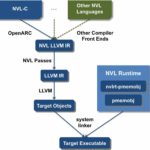The recent proliferation of new hardware technologies has galvanized the high-performance computing (HPC) community and created the ability to deliver the nation’s forthcoming exascale-capable supercomputers and data centers. It has also made LLVM-based compiler technology the default gatekeeper to these new systems. LLVM, an open-source collection of compiler and toolchain technologies, serves as a test bed for proposed parallelization extensions (e.g., the interoperability directive in OpenMP 5.1) and as a vehicle to provide production-quality parallel compiler implementations. Johannes Doerfert, a researcher at Argonne National Laboratory, notes that “LLVM is a vehicle to provide performant implementations of OpenMP….
Podcast: How Community Collaboration Drives Compiler Technology at the LLVM Project
In this Let’s Talk Exascale podcast, Hal Finkel of Argonne National Laboratory describes how community collaboration is driving compiler infrastructure at the LLVM project. “LLVM is important to a wide swath of technology professionals. Contributions shaping its development have come from individuals, academia, DOE and other government entities, and industry, including some of the most prominent tech companies in the world, both inside and outside of the traditional high-performance computing space.”
Parallware: LLVM-Based Tool for Guided Parallelization with OpenMP
Manuel Arenaz from Appentra presented this talk at the OpenMP booth at SC16. “Parallware is a new technology for static analysis of programs based on the production-grade LLVM compiler infrastructure. Using a fast, extensible hierarchical classification scheme to address dependence analysis, it discovers parallelism and annotates the source code with the most appropriate OpenMP & OpenACC directives.”
ORNL Creates Programming System for NVM Main Memory Systems
Researchers at the Future Technologies Group at Oak Ridge National Laboratory (ORNL) have developed a novel programming system that extends C with intuitive, language-level support for programming NVM as persistent, high-performance main memory; the prototype system is named NVL-C.







